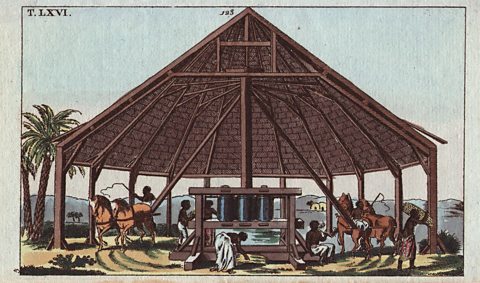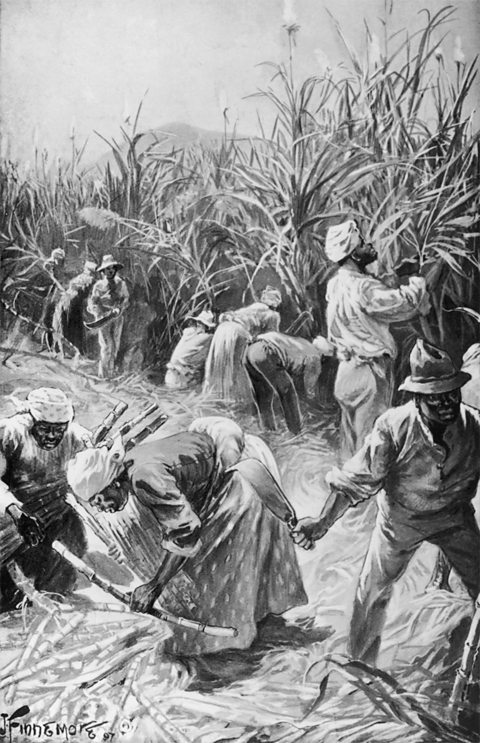The importance of the West Indian colonies
Increasing numbers of enslaved people were transported across the Atlantic because of the new form of farming that developed in the European colonies of the New World.
As Europeans conquered the Americas, large amounts of fertile land in tropical climates became available. This land was used for plantations.
Growth of plantations
Plantations were a new economic and social institution. They were both farm and factory.

Unlike landed estates in Britain, most plantations specialized in one crop such as sugar cane, cotton or tobacco for export production.
Large scale specialist plantations of at least 80 to 100 hectares (33 to 41 acres) were much more efficient than small farms.
Many plantations were big businesses. Operations were directed by hired managers (often on behalf of absentee owners back in Britain).
Plantations required a large labour force to sustain production. Planters turned to enslaved people as their main source of labour.
In the West Indies, Europeans created large plantations. Their success led owners to replicate the plantation model on neighbouring islands. More and more planters sought to purchase enslaved Africans in growing numbers.
The rush to produce sugar
Settlers in the tropical parts of America had found a crop that was in massive demand - sugar.

Sugar was cheaper than other sweeteners, and could transform a drab and monotonous diet. There was a ready market in Europe. As more was grown, it became cheaper and more people could afford it. In 1600 sugar was a delicacy for the rich. By 1800 many ordinary people were taking it in their tea.
The sugar trade could be very profitable. Sugar could be made from sugar cane but the process was very intensive. It took 50 tons of sugar cane to make one ton of sugar.
Production required a large labour force to plant, maintain, harvest and process the sugar cane. All of this was in harsh and unpleasant conditions.
Cheap labour
To keep profits high, plantation owners wanted a cheap labour force, and quickly, to cultivate and process the sugar. They decided that enslaved African people were the answer. As a result the Atlantic slave trade developed.
The most dramatic surge in sugar production took place on the largest islands - St Dominique, Jamaica and Cuba. By 1775, Jamaica produced half of Britain’s sugar.
These three islands were the largest disembarkation points for enslaved people in the West Indies. The numbers of enslaved people arriving on the islands grew to rival the Brazilian ports.
Historian David Olusoga visits a modern sugar cane harvest and sees how little has changed since the days of slavery.